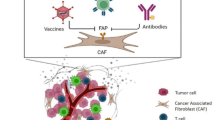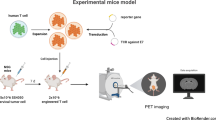Abstract
An ascitic lymphosarcoma (LS-A) of Swiss mice that regressed spontaneously on subcutaneous (s.c.) transplantation was investigated for the mechanism of its progressive growth and host mortality on intraperitoneal (i.p.) transplantation. In vitro studies indicated significant inhibition of LS-A proliferation seeded at higher cell density (>104/ml). Culture supernatants of LS-A caused bi-modal growth effects, the early supernatants (24 h) caused stimulation and the late (72 h) supernatants inhibited LS-A proliferation. The 72-h supernatants also suppressed T and B cell response to mitogens in a dose-dependent manner. Pan anti-transforming growth factor-β antibody abrogated the inhibitory effects of supernatants. The supernatants contained both latent as well as bio-active form of transforming growth factor-β1 (TGF-β1) as determined by ELISA. Mice bearing i.p. ascites tumor had elevated serum TGF-β1, hemoglobulinemia, splenic lymphopenia, impaired response of the T cells to mitogen and reduced expression of transferrin receptor (CD71) on the bone marrow cells. However, mice which rejected s.c. transplants, did not show significant changes in these parameters. Our studies indicated profound influence of site of tumor growth on tumor progression and host immune system mediated by tumor-derived TGF-β1. It is possible that human tumors which secrete TGF-β1 may exhibit similar patho-physiological effects in the host depending on the anatomical site of the tumor.









Similar content being viewed by others
References
Akhurst RJ, Derynck R (2001) TGF-β signaling in cancer—a double-edged sword. Trends Cell Biol 11:S44–S51
Balasubramaniam P, Malathi A (1992) Comparative study of hemoglobin estimated by Drabkin’s and Sahli’s methods. J Post Grad Med 38:8–9
Bodmer S, Srommer K, Frei K, Siepl C, de,Tribolet N, Heid I, Fontana A (1989) Immunosuppression and transforming growth factor beta in glioblastoma. Preferential production of transforming growth factor beta2. J Immunol 143:3222–3229
Burbridge MF, Kraus-Berthier L, Naze M, Pierre A, Atassi G, Guilbaud N (1999) Biological and pharmacological characterization of three models of human ovarian carcinoma established in nude mice: use of the CA 125 tumor marker to predict antitumor activity. Int J Oncol 15:1155–1162
Chouaib S, Asselin-Paturel C, Mami-Chouaib F, Caignard A, Blay JY (1997) The host-tumor immune conflict: from immnosuppression to resistance and destruction. Immunol Today 18:493–497
Czarniecki W, Chiu HH, Wong GH, Mc Cabe SM, Palladino MA (1988) Transforming growth factor beta 1 modulates the expression of class II histocompatibility antigens on human cells. J Immunol 140:4217–4223
De Coteau JF, Knaus PI, Yankelev H, Reis MD, Lowsky R, Lodish HF, Kadin ME (1997) Loss of functional cell surface transforming growth factor beta (TGF-β) type I receptor correlate with insensitivity to TGF-β in chronic lymphocyte leukemia. Proc Natl Acad Sci USA 94:5877–5881
Donelli MG, Russo R, Garattini S (1975) Selective chemotherapy in relation to the site of tumor transplantation. Int J Cancer 32:78–88
Fischer JR, Darjes H, Schindel M, Drings P, Krammer PH (1994) Constitutive secretion of bioactive transforming growth factor beta1 by small cell lung cancer cell lines. Eur J Cancer 30A:2125–2129
Garba L, Frelinger JA (2001) Intracellular cytokine staining for TGF-beta. J Immunol Methods 258:193–198
Hamilton TC, Young RC, Louie KG, Behrens BC, McKoy WM, Grotzinger KR (1984) Characterization of a xenografts model of human ovarian carcinoma which produces ascites and intraabdominal carcinomatosis in mice. Cancer Res 44:5286–5290
Hentze MW, Kuhn LC (1996) Molecular control of vertebrate iron metabolism: mRNA-based regulatory circuits operated by iron, nitric oxide and oxidative stress Proc Natl Acad Sci USA 93:8175–8182
Kehrl JH, Wakefield LM, Roberts AB, Jakowlew S, Alvarez-Mon M, Derynck R, Sporn MB, Fauci AS (1986) Production of transforming growth factor β by human T lymphocytes and its potential role in the regulation of T cell growth. J Exp Med 163:1037–1050
Keyes KA, Mann L, Teicher B, Alvarez E (2003) Site-dependent angiogenic cytokine production in human tumor xenografts. Cytokine 21:98–104
Khar A (1993) Characterization of spontaneous immunological rejection in a histiocytoma. I. Role of NK cell and anti tumor antibodies. Int J Oncol 3:393–398
Kloen P, Jennings CL, Gebhardt MC, Springfield DS, Mankin HJ (1994) Expression of transforming growth factor beta (TGF-β) receptors. TGF-β1 and TGF-β2 production and autocrine growth control in osteosarcoma cells. Int J Cancer 58:440–445
Kumar M, Seshadri M, Poduval TB, Chauhan PS, Sundaram K (1987) Cytogenetic studies on murine lymphosarcoma. Adv Biosci 6:35–44
Liaw FD, Denkins YM, Collins JH, Van Arsdall M, Chang JL, Chakrabarty S, Nguyen D, Kruzel E, Fidler IJ (2002) Type-1 transforming growth factor-beta differentially modulates tumoricidal activity of murine peritoneal macrophages against metastatic variants of the B16 murine melanoma. J Exp Ther Oncol 2:286–297
Mesiano S, Ferrara N, Jaffe RB (1998) Role of vascular endothelial growth factor in ovarian cancer: Inhibition of ascites formation by neutralization. Am J Pathol 153:1249–1256
Morikane K, Tempero R, Sivinski CL, Kitajima S, Gendler SJ, Hollingsworth MA (2001) Influence of organ site and tumor cell type on MUC1-specific tumor immunity. Int Immunol 13:233–240
Morris PC, Scholten V (1996) Osmotic lysis of tumor spill in ovarian cancer: a murine model. Am J Obstet Gynecol 175:1489–1492
Nakajima M, Morikawa K, Fabra A, Bucana CD, Fidler IJ (1990) Influence of organ environment on extracellular matrix degradative activity and metastasis of human colon carcinoma cells. J Natl Cancer Inst 82:1890–1898
Oklu R, Hasketh R (2000) The latent transforming growth factor beta binding protein (LTBP) family. Biochem. J 352:601–610
Papac RJ (1996) Spontaneous regression of cancer. Cancer Treat Rev 22:395–423
Paterson C, Davies M, Stone A, Huntley S, Smith E, Pring M, Eveson JW, Robinson CM, Parkinson EK, Prime SS (2002) TGF-beta 1 acts as a tumor suppressor of human malignant keratinocytes independently of Smad 4 expression and ligand-induced G(1) arrest. Oncogene 21:1616–1624
Roberts B, Flanders KC, Kondaiah P, Thompson NL, Obberghen- Schilling E, Wakfield L, Rossi P, de Cambrugghe B, Heine U, Sporn MB (1988)Transforming growth factor beta: biochemistry and roles in embriogenesis, tissue repair and remodeling and carcinogenesis. Recent Prog Horm Res 44:157–168
Roberts B, Flanders KC, Heine UI, Jakowlew S, Kondaiah P, Kim SJ, Sporn MB (1990) Transforming growth factor-beta: multifunctional regulator of differentiation and development. Philos Trans R Soc Lond B Biol Sci 327:145–154
Rodeck U, Bosller A, Graeven U, Fox FE, Nowell PC, Knabbe K, Kari C (1994) Transforming growth factor beta production and responsiveness in normal human melanocytes and melanoma cells. Cancer Res 54:575–581
Saharinen J, Hyytiainen M, Taipale J, Keski-Oja J (1999) Latent transforming growth factor beta binding proteins (LTBPs)– structural extracellular matrix proteins for targeting TGF beta action. Cytokine Growth Factor Rev 10:99–117
Schomaker SJ, Clemo FA, Amacher DE(2002) Analysis of rat bone marrow by flow cytometry following in vivo exposure to cyclohexanone oxime or daunomycin HCl. Toxicol Appl Pharmacol 185:48–54
Schwarz RE, McCarty TM, Peralta EA, Diamond DJ, Ellenhorn JD (1999) An orthotopic in vivo model of human pancreatic cancer. Surgery 126:562–567
Shim KS, Kim KH, Han WS, Park EB (1999) Elevated serum levels of transforming growth factor-beta1 in patients with colorectal carcinoma: its association with tumor progression and its significant decrease after curative surgical resection. Cancer 85:554–561
Staroselsky N, Fan D, O’Brian CA, Bucana CD, Gupta KP, Fidler IJ (1990) Site-dependent differences in response of the UV-2237 murine fibrosarcoma to systemic therapy with adriamycin. Cancer Res 50:7775–7782
Tan MH, Chu TM (1985) Characterization of the mouse tumorigenic and metastatic properties of a human pancreatic tumor cell line (AsPC-1) implanted orthotopically into nude mice. Tumor Biol 6:89–98
Thakur VS, Seshadri M, Shah DH, Poduval TB (1997) Adoptive immunotherapy of murine lymphosaroma: comparative study using allo-immune or tumor-immune T cells. Ind J Exp Biol 35:581–588
Vanky F, Nagy N, Hising C, Sjovall K, Larson B, Klein E (1997) Human ex vivo carcinoma cells produce transforming growth factor-β and thereby can inhibit lymphocyte function in vitro. Cancer Immnol Immunother 43:317–323
Wilmanns C, Fan D, O’Brian CA, Bucana CD, Fidler IJ (1992) Orthotopic and ectopic organ environments differentially influence the sensitivity of murine colon carcinoma cells to doxorubicin and 5-fluorouracil. Int J Cancer 52:98–104
Acknowledgements
The authors, thank Shri S. Santosh Kumar for critically going through the manuscript and Shri N.S. Sidnalkar, also, Shri K.S. Munankar for their expert technical help in animal experiments.
Author information
Authors and Affiliations
Corresponding author
Rights and permissions
About this article
Cite this article
Thakur, V.S., Shankar, B., Chatterjee, S. et al. Role of tumor-derived transforming growth factor-β1 (TGF-β1) in site-dependent tumorigenicity of murine ascitic lymphosarcoma. Cancer Immunol Immunother 54, 837–847 (2005). https://doi.org/10.1007/s00262-004-0656-z
Received:
Accepted:
Published:
Issue Date:
DOI: https://doi.org/10.1007/s00262-004-0656-z




